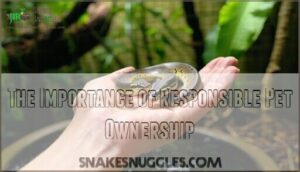This site is supported by our readers. We may earn a commission, at no cost to you, if you purchase through links.

But the world outside your living room doesn’t play by the same rules: one chilly night or an empty patch of grass can spell disaster. The truth is, can pet snakes survive in the wild isn’t just a matter of instinct.
Your snake faces harsh odds: hunger, climate swings, predators, and dilemmas no heat lamp or cozy hide can solve. Even one released snake can turn the rhythm of local ecosystems upside down.
Table Of Contents
Key Takeaways
- Most pet snakes can’t survive in the wild because they struggle with extreme temperatures, unpredictable food sources, and predators.
- Releasing pet snakes harms local ecosystems by disrupting food webs, introducing disease, and outcompeting native wildlife.
- Escaped or released pet snakes face high risks of starvation, exposure, sickness, and rarely survive more than a few weeks outdoors.
- Letting a snake go can bring legal trouble, while responsible rehoming options exist through breeders, rescues, or reputable communities.
Can Pet Snakes Survive in The Wild?
If you’re wondering whether pet snakes can survive outside their tanks, there’s a lot to think about. Survival in the wild isn’t as simple as it might seem. Let’s look at the main challenges they’d face.
Climate
Step outside for a moment and you’ll see just how quickly the weather can change—imagine trying to survive that wild ride when your body depends entirely on the warmth around you. Pet snakes come from carefully managed environments, which provide them with stable temperatures and humidity. But left outdoors, they’re exposed to dramatic swings in temperature, unpredictable seasonal changes, and climate extremes that can be fatal. Most wild regions just aren’t suited to their needs.
- Temperature regulation becomes nearly impossible
- Sunlight and humidity vary wildly
- Habitat suitability is unpredictable
Food Sources
If you think about climate challenges, food is the next big hurdle for pet snakes in the wild. Your snake’s hunting abilities are shaped by captivity—a steady diet, predictable meals, and no real need for animal instinct.
But outside, prey availability shifts with the seasons and competition. Wild snakes rely on stealth and ambush, catching mice, rats, lizards, or birds, sometimes eating prey up to half their own weight. Pet snakes often struggle to match these hunting skills, especially after years of a captive diet.
It’s worth noting that pre-killed prey is a safe alternative to live prey. Their feeding frequency and dietary needs may not align with the unpredictable wild diet, making survival a constant gamble in the predator-prey relationship.
Predators
After food, predators quickly become your snake’s biggest worry. Avian predators like hawks and owls, mammalian threats such as bobcats and raccoons, and even reptilian predators—including other snakes—can all hunt released pets. Human impact, from roadkill to habitat change, raises the stakes further.
Survival rates plummet as captive snakes lack predator avoidance skills. The challenges of surviving in the wild are real, and the predator-prey relationship rarely favors inexperienced newcomers. Some animals, like the mongoose, prey on snakes, making survival even more difficult.
Sickness and Disease
Battling predators is just the start—snakes set loose outdoors soon face a gauntlet of sickness and disease, most of which they’re simply not ready for. Without regular veterinary care, health risks for snakes in the wild multiply:
- Scale rot and mouth rot from harsh conditions
- Intestinal worms and new parasites
- Ticks and mites introducing diseases
- Zoonotic disease transmission to native wildlife
The Dangers of Releasing Pet Snakes
Letting a pet snake loose might seem harmless, but it comes with real risks for both wildlife and people. Before making any decisions, it’s important to know exactly what’s at stake.
Here’s what you need to watch out for if you’re considering this option.
Disruption of Ecosystems
Think of your local ecosystem as a finely tuned orchestra. Introduce a nonnative snake, and suddenly key notes vanish—native species get outcompeted, resources dwindle, and the rhythm of life stumbles.
When that happens, the entire habitat can shift—domino effects ripple through the food web, and biodiversity suffers.
Invasive newcomers often bring the added threat of disease, quietly unraveling the natural balance that holds these wildlife communities together.
Threat to Humans
Accidents aren’t the only danger—when a pet snake ends up loose, people in the neighborhood can quickly find themselves facing unexpected risks. Imagine a loose snake in the park or yard; here’s what can unfold:
- Unintended Snake Bites—especially for curious children exploring the grass.
- Venom Exposure threatens public safety, even from exotic species once sold as pets.
- Zoonotic Diseases—hidden threats, carried silently, can transfer to humans through contact.
Danger for The Snake
When a pet snake finds itself in unfamiliar territory, the odds are almost never in its favor. Accustomed to regular feedings and stable temperatures, it’s suddenly facing starvation risks, predator vulnerability, and climate susceptibility.
Unable to hunt, lacking natural instincts to avoid predators, and facing a higher chance of catching diseases—all these challenges make it especially risky to set a pet snake loose in the wild.
Understanding The Concept of The Wild
When you imagine “the wild,” it isn’t just endless woods or deserts—it’s a whole system where every animal has a role. Your surroundings, whether city or countryside, shape what’s possible for a snake outside captivity.
To understand what that really means for pet snakes, let’s look at the environments they might encounter.
Natural Habitat Vs. Urban Environments
Ever wonder how a snake would fare swapping wide-open wilderness for crowded city streets? The reality isn’t pretty. Urban Snake Habitats bring a harsh mix of noise, traffic, and Habitat Fragmentation, making survival tough. Consider these five environmental factors affecting snake survival:
- Concrete replaces hiding spots—a tough break for shy reptiles.
- Food is scarce, unlike the buffet of their natural habitat.
- Weather swings wildly without nature’s shelter.
- Resource Availability is unreliable and often dangerous.
- Human Interaction increases injury and capture risk.
That’s why the risks of releasing pet snakes are so high.
Impact on Native Wildlife
Picture tossing a stone into a still pond—the ripples spread far and wide. That’s how releasing nonnative snakes can shake up local ecosystems. You’ll see heightened predation rates, sudden competition effects, and shifts in food webs as invasive species prey on native wildlife and outcompete them for resources.
These changes can quickly lead to a drop in biodiversity, throwing the local ecosystem off balance.
On top of that, when snakes are introduced, they may bring along unfamiliar diseases, which can silently spread and put even more stress on native species—sometimes with lasting, damaging effects.
Invasive Species and Legal Issues
When pet snakes end up where they don’t belong, local wildlife and communities can feel the ripple effect. Sometimes, releasing a non-native snake isn’t just risky—it can land you in legal trouble too.
Here’s what you should know before making any decisions.
Negative Effects on Local Populations
Imagine a single snake shifting the balance of an entire ecosystem. Introduce a nonnative species, and you risk a cascade of issues that spiral beyond control. Released pet snakes compete aggressively for food and shelter, often pushing native wildlife out. The consequences ripple outward, disturbing food webs and accelerating population decline in sensitive species. Along the way, they might introduce new diseases, further compromising local biodiversity. Here’s what you might see:
- Intense species competition for resources
- Displacement of native animals
- Altered food web structure
- Surging predation on vulnerable species
- Escalating disease spread
Legal Consequences of Releasing Non-Native Snakes
Pushing the local ecosystem out of balance isn’t the only danger. Releasing pet snakes comes with serious legal weight. Federal penalties can include heavy fines and jail time, with State fines adding another layer. Permit revocation isn’t rare, and civil liability means you’ll pay for environmental cleanup. Trade restrictions increase risks: transport or sale of invasive species brings steep punishment. Here’s a quick look:
| Penalty Type | Consequence Example |
|---|---|
| Federal Penalties | Fines up to $50,000 |
| State Fines | License/permit loss |
| Permit Revocation | Permanent, no appeal |
| Civil Liability | Cleanup or capture costs |
Alternative Options for Rehoming Pet Snakes
If letting your snake go isn’t an option, you do have solid choices for finding it a new home. Some of these are easier than others, and a couple might surprise you.
Here’s what you can try next.
Return Policies From Suppliers
Before you look into other options, it’s worth checking if the seller you got your snake from has a return policy that can help both you and your animal. Many suppliers outline Supplier Agreements or Breeder Standards, sometimes including Health Guarantees or details about Refund Eligibility.
Gather receipts and paperwork—these will smooth the process and clarify if you’re within a refund window. These policies often hinge on Ethical Sourcing, ensuring that responsible choices aren’t just about your situation but also about reducing risks of snake ownership and the unintended impact of releasing pet snakes.
Selling or Advertising The Snake
If returning your snake isn’t an option, you might find that connecting with other reptile enthusiasts—or sharing an honest online listing—can quickly open new doors for your pet.
Ethical Advertising targets responsible breeding while discouraging snake misinformation and the risks of the exotic pet trade.
Focus your Online Sales on your Target Audience to boost animal health and welfare—and promote responsible pet ownership.
Seeking Assistance From Professionals
When selling or advertising just isn’t the right fit, reaching out to seasoned professionals can take a load off your shoulders and make all the difference for your snake’s future. Herpetological Societies, reputable reptile rescues, and veterinarians specializing in exotics have seen nearly every scenario. They offer not just snake rehoming guidance but real-world solutions rooted in ethical considerations and proper care.
- Compassionate Rescue Organizations guarantee lifelong welfare
- Veterinarian Expertise streamlines safe snake relocation
- Experienced pet owners from local networks welcome alternative options for snakes
The Importance of Responsible Pet Ownership
Responsible snake ownership starts long before you bring one home. It means understanding what your pet needs, from space to daily care.
Let’s look at some key things every owner should keep in mind.
Researching and Understanding The Needs of Pet Snakes
Bringing a snake into your home isn’t just about filling a tank—it’s about understanding a world as different from ours as the deep sea or desert sands.
Each species comes with its own set of needs—like tailored habitats and the right diet, and sometimes a vet who specializes in reptiles.
By tuning in to your snake’s natural instincts and behaviors, you can shape a home where your pet truly feels at ease.
Commitment to Providing Proper Care
Caring deeply for your snake really shows in the everyday things—like keeping its home safe, clean, and just a bit more stimulating.
Staying committed for the long haul means getting creative with enrichment, tuning in to your snake’s unique needs, and budgeting ahead for expenses like food and vet visits.
Proper care isn’t a luxury—it’s the foundation for health and longevity. Ethical sourcing matters too; choosing reputable suppliers reinforces responsible reptile care from the start.
Seeking Advice and Support From Experts
Whether you’re facing a tricky question or just hoping to do right by your snake, connecting with people who’ve been down this road before can make all the difference. Lean on these resources:
- Book regular veterinarian consultations and seek out herpetologist insights for precise advice on snake behavior and care.
- Reach out to snake rescues and attend expert workshops—practical spaces for learning ethical snakekeeping.
- Join reputable online forums, where experienced keepers discuss educating the public about snake care and problem-solving in real time.
Frequently Asked Questions (FAQs)
How do pet snakes adapt to new territories?
Pet snakes experience severe environmental stressors during territory transitions, struggling with behavioral changes and physiological adaptation.
Learning new prey patterns proves difficult, making nonnative snakes vulnerable and potentially disruptive to local ecosystems.
What happens if a pet snake escapes accidentally?
Escape risks are immediate—an accidental release can lead to ecosystem disruption if your pet snake survives.
Quick snake identification, calling local resources, and strong prevention methods all help minimize the likelihood of nonnative snakes impacting local ecosystems.
Do pet snakes recognize their former owners in the wild?
Recognizing a human in the chaos of the wild—through scent, voice, or touch—stretches the limits of snake cognition. Imprinting evidence falls short; memory capacity in captive-bred snakes fades quickly.
Domestication rarely overrides survival instincts after releasing pet snakes.
Can pet snakes breed with wild native snakes?
Hybrid offspring between pet snakes and wild native snakes are rare, thanks to genetic incompatibility and reproductive isolation.
Even if hybrid vigor occurs, those matings often disrupt genetic diversity, pose invasive species risks, and threaten local ecosystems with unpredictable evolutionary consequences.
How do weather changes affect pet snake survival?
Less than 50% of released captive snakes survive a year outdoors. Sudden Temperature Drops and Extreme Weather Events, combined with Humidity Level Changes, Seasonal Acclimation Issues, and unpredictable Hibernation Challenges, often prove fatal in a wild environment.
Conclusion
Only about 10% of released pet snakes survive more than a few weeks in the wild. That number tells a stark story: while you might wonder, can pet snakes survive in the wild, your companion faces steep odds.
Cold snaps, scarcity of familiar food, and native predators quickly tip the balance.
Choosing responsible action safeguards both your snake and local wildlife—reminding us that true guardianship means looking beyond release, toward thoughtful, humane solutions every time.
- https://pmc.ncbi.nlm.nih.gov/articles/PMC10100070/
- https://www.reddit.com/r/snakes/comments/6dawjc/what_is_the_survival_rate_of_baby_snakes_in_the/
- https://a-z-animals.com/animals/snake/how-long-do-snakes-live/
- https://www.worldanimalprotection.ca/our-work/wildlife/snakes-are-wildlife-not-pets/
- https://www.glerl.noaa.gov/blog/2023/08/16/from-interesting-pet-to-invasive-species-the-dangers-of-releasing-exotic-plants-and-animals-into-the-wild/













